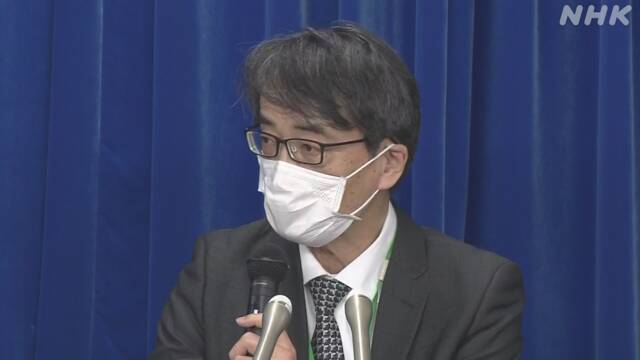An expert meeting of the Ministry of Health, Labor and Welfare was held to advise on measures against the new coronavirus. He pointed out that the number of cases where emergency transportation is difficult exceeds the fifth wave of infection last summer, which puts a heavy burden on emergency medical care.
He said, "Infection will continue to spread nationwide in the short term," and called for thorough infection control measures such as proper wearing of non-woven masks and ventilation, as well as avoiding even one denseness based on the characteristics of Omicron strains. ..
専門家会合は今回の感染者の急増について忘年会やクリスマス、年末年始や今月の3連休などで接触機会が増えた影響が大きかったものの、感染の場は家庭や職場、学校、医療機関、介護施設などに広がりつつあるとしていて「今後も少なくとも短期的には全国で拡大が継続すると考えられる」と分析しました。
そしてほぼすべての地域で新規感染者の急速な増加が続いていて、年代別では20代の感染が減少する一方10歳未満が増加しているとしています。
一方、沖縄県では20代を中心にした若い世代の感染が減少する一方で60代以上で増加し入院するケースが増加し続けていると指摘し、今後、他の地域でも同様の傾向が見られる可能性があると注意を呼びかけました。
また感染の急拡大で軽症、中等症の患者の医療体制が急速にひっ迫する可能性があるほか、その後、高齢者に感染が広がって重症者が増加し感染によって基礎疾患のある人の状態が悪化するなどして入院が必要な患者が増加することに注意が必要だとしています。
さらに救急搬送が困難なケースが去年夏の感染の第5波を上回るなど、特に救急医療に大きな負荷がかかっていると指摘しました。
一方、専門家会合はオミクロン株のうち「BA.2」と呼ばれる系統のウイルスが海外の一部の地域で拡大し、国内でも検疫などで見つかっているとしています。
「BA.2」は現在最も広がっているオミクロン株の系統と比べて入院に至る割合が異なるかどうか明確ではないものの、ゲノム解析など調査を続ける必要があるとしています。
Based on this analysis, it is necessary for the expert meeting to promptly implement measures according to the characteristics of the Omicron strain, reduce contact opportunities by utilizing telework, etc. in order to maintain social functions, and avoid going out even if it is one secret. In addition to avoiding crowded places and situations with a high risk of infection, we called for thorough basic infection control measures such as proper wearing of non-woven masks, disinfection of fingers, and ventilation.
Chair Wakita "It is not clear at what point it will start to decline."
At a press conference after the Ministry of Health, Labor and Welfare's expert meeting, Chairman Takaji Wakita commented on the future infection status of Omicron strains: "In many overseas countries, the number of infected people per capita is about 10 times that of Japan. It is possible that herd immunity has been acquired to a certain extent in such countries and the epidemic has begun to converge. However, such a situation has not yet been reached in Japan. It was argued that it was not yet clear at this point whether it would head down. In Okinawa, the epidemic seems to have passed its peak, but the number of infected young people is declining, but it is increasing among the elderly. The rate of decrease in the number of infected people is slow, and there is a possibility that a tendency like Okinawa Prefecture will be seen in other areas in the future. It is necessary to pay more attention to the future situation. "
Number of newly infected people 2.21 times the previous week
According to the materials presented at the expert meeting, the number of newly infected people in the week up to the 25th is 2.21 times that of the previous week, and the number of newly infected people continues to spread rapidly nationwide.
In areas where the extension of priority measures such as spread prevention has been decided, Hiroshima prefecture has continued to increase by 1.37 times and Yamaguchi prefecture by 1.43 times.
On the other hand, Okinawa prefecture decreased by 0.80 times.
From the 21st of this month, in areas where priority measures such as spread prevention are applied, the number of prefectures in the Tokyo metropolitan area increased by 2.51 times in Tokyo, 2.65 times in Kanagawa prefecture, 2.45 times in Chiba prefecture, and 2.40 times in Saitama prefecture. Is continuing.
In addition, Niigata prefecture is 1.93 times, Gunma prefecture is 2.37 times, Tokai 3 prefectures are 2.47 times, Gifu prefecture is 2.31 times, Mie prefecture is 1.89 times, Kagawa prefecture is 2.32 times, and Nagasaki prefecture is. It is 2.60 times, 1.84 times in Kumamoto prefecture, and 2.71 times in Miyazaki prefecture.
Furthermore, from the 27th, in areas where priority measures such as spread prevention are applied, 2.84 times in Hokkaido, 1.88 times in Aomori prefecture, 2.46 times in Yamagata prefecture, 2.52 times in Fukushima prefecture, 2.48 times in Ibaraki prefecture, 2.13 times in Tochigi prefecture, Ishikawa prefecture 3.29 times, Nagano prefecture 1.98 times, Shizuoka prefecture 2.44 times, Kyoto prefecture 2.01 times, Osaka prefecture 2.02 times, Hyogo prefecture 2.57 times, Shimane prefecture 1.68 times, Okayama prefecture 2.69 times, Fukuoka prefecture It increased by 2.73 times, 1.80 times in Saga prefecture, 2.85 times in Oita prefecture, and 2.33 times in Kagoshima prefecture.
Looking at the current infection status in the last week per 100,000 population, Okinawa prefecture has the highest number of infected people, 547.40, Osaka prefecture 512.54, Tokyo 482.11, Kyoto prefecture 374.42, Fukuoka prefecture 350.17. The number of people is 339.52 in Hyogo prefecture and 334.29 in Hiroshima prefecture, which is the highest number ever at 276.33 in Japan.

